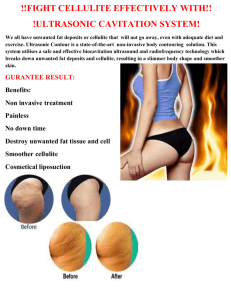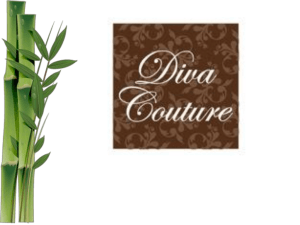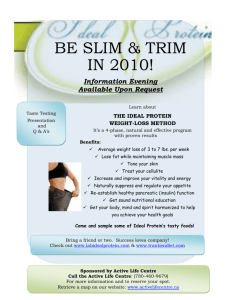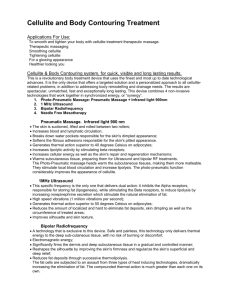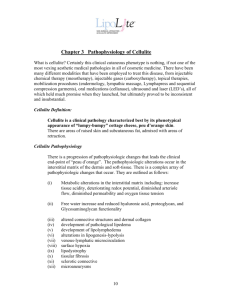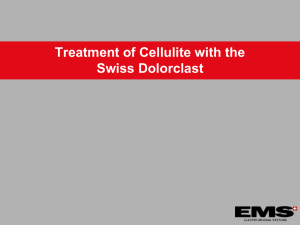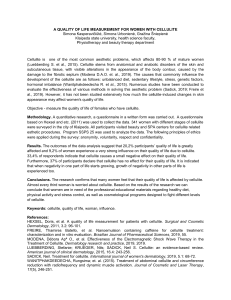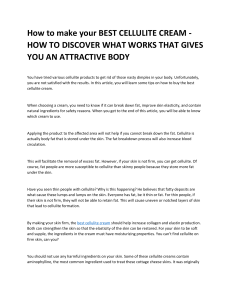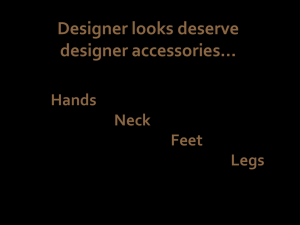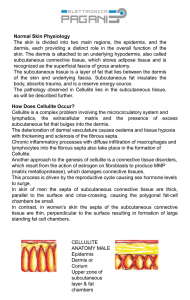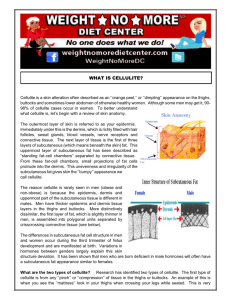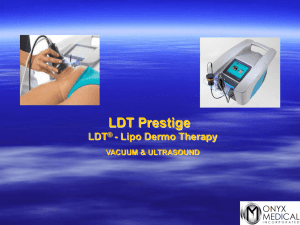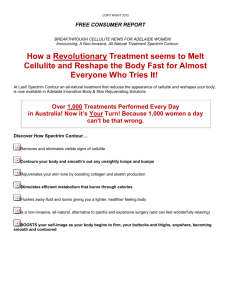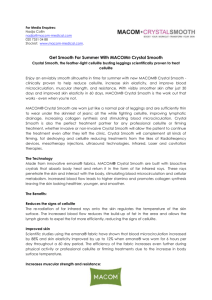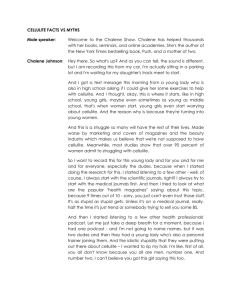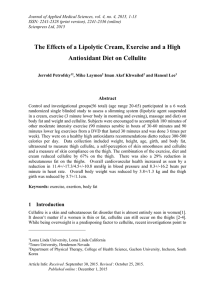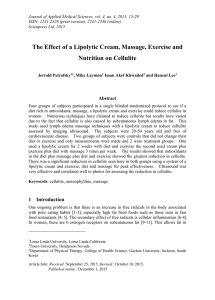Body Allure Clinicals Objective: The purpose of this study is to
advertisement
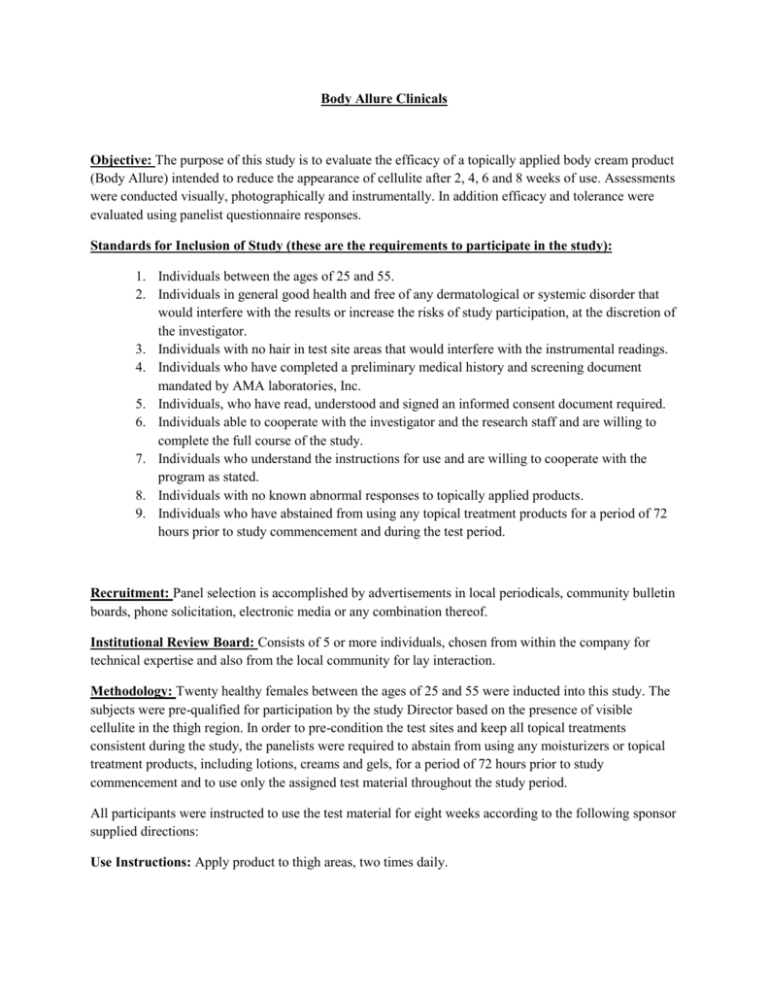
Body Allure Clinicals Objective: The purpose of this study is to evaluate the efficacy of a topically applied body cream product (Body Allure) intended to reduce the appearance of cellulite after 2, 4, 6 and 8 weeks of use. Assessments were conducted visually, photographically and instrumentally. In addition efficacy and tolerance were evaluated using panelist questionnaire responses. Standards for Inclusion of Study (these are the requirements to participate in the study): 1. Individuals between the ages of 25 and 55. 2. Individuals in general good health and free of any dermatological or systemic disorder that would interfere with the results or increase the risks of study participation, at the discretion of the investigator. 3. Individuals with no hair in test site areas that would interfere with the instrumental readings. 4. Individuals who have completed a preliminary medical history and screening document mandated by AMA laboratories, Inc. 5. Individuals, who have read, understood and signed an informed consent document required. 6. Individuals able to cooperate with the investigator and the research staff and are willing to complete the full course of the study. 7. Individuals who understand the instructions for use and are willing to cooperate with the program as stated. 8. Individuals with no known abnormal responses to topically applied products. 9. Individuals who have abstained from using any topical treatment products for a period of 72 hours prior to study commencement and during the test period. Recruitment: Panel selection is accomplished by advertisements in local periodicals, community bulletin boards, phone solicitation, electronic media or any combination thereof. Institutional Review Board: Consists of 5 or more individuals, chosen from within the company for technical expertise and also from the local community for lay interaction. Methodology: Twenty healthy females between the ages of 25 and 55 were inducted into this study. The subjects were pre-qualified for participation by the study Director based on the presence of visible cellulite in the thigh region. In order to pre-condition the test sites and keep all topical treatments consistent during the study, the panelists were required to abstain from using any moisturizers or topical treatment products, including lotions, creams and gels, for a period of 72 hours prior to study commencement and to use only the assigned test material throughout the study period. All participants were instructed to use the test material for eight weeks according to the following sponsor supplied directions: Use Instructions: Apply product to thigh areas, two times daily. Participants were provided with a daily log and instructed to record the time of each application together with any subjective comments regarding product usage. Visual assessments and biophysical measurements were collected prior to the initial application during the preliminary visit to the testing facility and again after 2, 4, 6 and 8 weeks of use. On the evaluation days, panelists reported to the clinic without any topical treatments, having only applied the test material. Upon arrival, panelists were allowed to equilibrate to the ambient for the 30 minutes prior to the measurement. The following distinct noninvasive methods were employed as evaluation parameters: Cellulite Reduction Quantification of the cellulite condition was performed by a trained technician, using a modified and expanded version of the Fitzpatrick Wrinkle Evaluation Scale (ten point monadic scale), with one (1) representing the least visible discoloration and ten (10) showing the maximum condition in the region selected. Each woman had her condition evaluated, graded and separately photographed, by a scientific photographer, prior to the product being applied. The product was then applied in accordance with the intended package directions over an 8 week consumer in-use regimen. The modified and expanded 10-point monadic scaling method allows for the quantification and measurements of efficacy and is expressed as a percentage of cellulite reduction for each subject. The photographs of each woman’s selected cellulite region were placed side-by-side to compare the pretreated area with the post-treated area. The set of photographs thus provided a visual record of the efficacy of the product. Results Visual Reduction – Cellulite Visual Scoring Reduction in Surface Roughness – Visioscan Results Test Product Questionnaire Summary Week 8 Observations: No adverse effects or unexpected reactions of any kind were observed on any of the subjects. Conclusions: Within the limits imposed by the conduct and population size of the study described herein, twice daily use of the test product Body Allure demonstrated: Visual Reduction in Cellulite- Decreased appearance of cellulite at evaluations conducted after two, four, six and eight weeks of application. The following data collected on five subjects was observed in the treatment areas: When used in accordance with the intended package directions, the product significantly reduced the appearance of cellulite after just two weeks of treatment. Continued reduction in the condition was observed after 4, 6 and 8 weeks of use with a maximum reduction of 90% observed. Additionally, the data is statistically significant. Further, these phenomena were documented and confirmed by the photographic record made during the course of this study. Evaluations of Surface Roughness via Visioscan Decreases in the Visioscan parameters associated with surface roughness (SEr) were also observed. Moreover, these reductions are considered significant after 2 and 8 weeks use with a maximum reduction of 72.9% observed. Questionnaire Responses -Subjective responses (tabulated below) corroborated the visual data collected. Throughout the test period, the majority of test panelists perceived improvement in their skin for the conditions listed. Summation Twice daily use of the test product (Body Allure) reduced the appearance of cellulite. The results are considered statistically significant and were corroborated photographically, instrumentally and subjectively.
